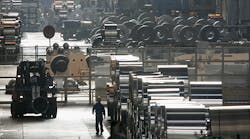Alcoa Inc., the 128-year-old company that invented modern aluminum processing, is formally splitting itself in two by hiving off most of its legacy mining and smelting assets.
From Nov. 1, the iconic name will be used by a new company, Alcoa Corp., that will hold its legacy metal-processing business, while valued car and jet parts businesses will go by the name of Arconic Inc., to be headed by current CEO Klaus Kleinfeld, the New York-based company said in a statement Thursday. The plan was formally approved by the board, it said.
Kleinfeld will also serve as Arconic chairman. Michael Morris will become non-executive chairman of Alcoa Corp. and Roy Harvey, who has been Alcoa’s president of global primary products, will be its CEO.
The split will free Arconic from many of the uncertainties of the commodities businesses, which have struggled amid a global metal glut that helped cut prices in half from their 2008 high. Meanwhile, the new Alcoa Corp. will begin its corporate life with reduced debt and may benefit from more than nine years of production cuts, curtailments and investments at its global operations.
“Some thought the separation should have happened years ago, while others thought the balance sheet was too complicated to allow for a separation at the present time,” Justin Bergner, an analyst at Gabelli & Co., said Thursday in an e-mail. “We suspect most investors will be happy to see two very different businesses map their own futures.”
The company, formally known as the Aluminum Company of America until 1999, was the world’s largest producer of the lightweight metal until 2007. Protected by patents on its industrial processes, Alcoa operated as a U.S. monopoly through 1940.
But by the time Paul O’Neill came to the company as CEO in 1987, the company was facing increased global competition. O’Neill’s response was to focus on expansion in primary-aluminum production in the U.S. and overseas. His successor, Alain Belda, spent a decade cutting costs and expanding through acquisitions including that of Salt Lake City-based Cordant Technologies Inc., a maker of engine parts and fasteners for aircraft.
After taking over as CEO in 2008, Kleinfeld emphasized value-added products while rationalizing the commodity-metals business. The former CEO of Siemens AG spent more than $3.5 billion to buy aerospace-components makers including RTI International Metals Inc., Tital GmbH and Firth Rixson Ltd. He also expanded existing facilities that fabricate aluminum used in the aerospace, energy and automotive sectors.
The separation, announced a year ago, will occur by means of a pro-rata distribution by Alcoa Inc. of 80.1% of the outstanding common stock of Alcoa Corp. Arconic will retain 19.9% of Alcoa Corp. common stock.
The new Alcoa will be listed on the New York Stock Exchange and trade under the ticker AA, while Arconic will trade as ARNC.
By Joe Deaux



